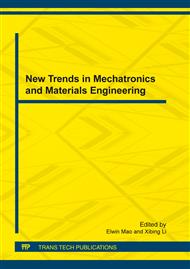[1]
A. M. Knapp, J. W. Halloran, Binder removal from ceramic-filled thermoplastic blends, J. Am. Ceram. Soc. 89[9] (2006) 2776-2781.
DOI: 10.1111/j.1551-2916.2006.01179.x
Google Scholar
[2]
S. Biamino, A. Antonini, M. Pavese, P. Fino, C. Badini, MoSi2 laminate processed by tape casting: Microstructure and mechanical properties' investigation, Intermetallics 16(2008) 758-768.
DOI: 10.1016/j.intermet.2008.02.007
Google Scholar
[3]
E. Roncari, P. Oinasco, M. Nagliati, D. Sciti, Tape casting of AlN-SiC-MoSi2 composites, J. Eur. Ceram. Soc. 24 (2004) 2303-2311.
DOI: 10.1016/j.jeurceramsoc.2003.08.004
Google Scholar
[4]
P. Geffroy, T. Chartier, J. Silvain, Preparation by tape casting and hot pressing of copper carbon composites films, J. Eur. Ceram. Soc. 27 (2007) 291-299.
DOI: 10.1016/j.jeurceramsoc.2006.04.054
Google Scholar
[5]
A. Das, G. Madras, N. Dasgupta, A. M. Umarji, Binder removal studies in ceramic thick shapes made by laminated object manufacturing, J. Eur. Ceram. Soc. 23(2003)1013-1017.
DOI: 10.1016/s0955-2219(02)00266-2
Google Scholar
[6]
L. Liau, B. Peters, D. Krueger, A. Gordon, D. S. Viswanath, D. J. Lombardo, Role of length scale on pressure increase and yield of poly (vinyl butyral ) – barium titanate- platinum multilayer ceramic capacitors during binder burnout, J. Am. Ceram. Soc. 83[11] (2000) 2645-2653.
DOI: 10.1111/j.1151-2916.2000.tb01609.x
Google Scholar
[7]
P. Calvert, M. Cima, Theoretical models for binder burnout, J. Am. Ceram. Soc. 73[3] (1990) 575-579.
Google Scholar
[8]
M. J. Cima, J. A. Lewis, A. D. Devoe, Binder distribution in ceramic greenware during thermolysis, J. Am. Ceram. Soc. 72[7] (1989) 1192-1199.
DOI: 10.1111/j.1151-2916.1989.tb09707.x
Google Scholar
[9]
D. M. Liu, W. J. Tseng, Binder removal from injection moulded zirconia ceramics, Ceram. Int. 25 (1999) 529-534.
DOI: 10.1016/s0272-8842(97)00090-4
Google Scholar
[10]
S. Masia, P. Calvert, W. E. Rhine, H. K. Bowen, Effect of oxides on binder burnout during ceramics processing. J. Mater. Sci. 24 (1989) 1907-1912.
DOI: 10.1007/bf02385397
Google Scholar
[11]
H. H. Angermann, O.V. Biest, Low temperature debinding kinetics of two-component model systems. Int. J. Powder Metall. 29 (1993) 239-250.
Google Scholar


